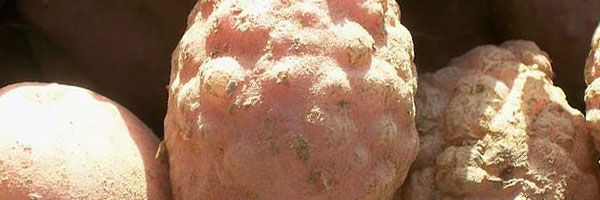
Meloidogyne spp.
(Root-knot nematodes)
- Causal agents and transmission
Currently the genus Meloidogyne comprises more than 90 described species and most of these are obligate parasites on plant roots and below-ground plant organs. Six of them are major agricultural pests and known to damage potato crops by reducing yield and affecting tuber quality with external deformations (gall) and internal flesh necroses.
These root-knot nematodes (RKN) are obligate sedentary endoparasites which complete almost all their life cycle within the host. Besides the vermiform adult male, only the larval stage (J2) is motile and is the infective stage.
The feeding activity within the potato tissues generates cell hypertrophy, leading to root and tuber deformations known as galls. These nematodes are extremely polyphagous and are able to multiply in numerous crops (sugar beetroot, carrot, cereals, rape, etc.) and weeds (nightshade, etc.).
- Diversity and distribution
Some species of Meloidogyne (RKN) are very common in hot climates, from the Mediterranean basin to the tropics: M. arenaria, M. javanica and M. incognita.
The observed damage on potato crops is not species specific and consists of root and tuber galls.
M. hapla, M. chitwoodi and M. fallax are species which are more adapted to temperate conditions and are present in Northern countries such as the Northern US states where M. chitwoodi was first described and Northern European countries where M. fallax was initially found as a deviating M. chitwoodi population.
- Significance
Meloidogyne species are very serious worldwide agronomical pests. For M. chitwoodi and M. fallax that have only recently been identified in Europe, records of occurrence have just been initiated. According to European legislation, both species are classified as quarantine parasites and are therefore subject to mandatory control measures.





